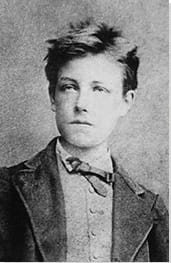Summary of Arthur Rimbaud
In a burst of youthful creativity that lasted just five-years, Rimbaud succeeded in formulating a radical and influential approach to writing poetry. His illogical and spontaneous methodology upset existing conventions and proved inspirational to many who followed; especially those with links to the Symbolist, Dadaist, and Surrealist movements. Having inexplicably given up on writing poetry by the tender age of twenty, he spent the remainder of his short life as a wanderer, and as a coffee and arms dealer on the African continent. Rimbaud's output might have been limited, but it has seen him firmly established as one of the most original and important writers of his generation, and, in his personal life, one of the great anti-authoritarian troublemakers in the mythology of the modernists.
Accomplishments
- Rimbaud fully tested the boundaries of traditional forms of verse. In an approach to writing verse he famously described as a "rational derangement of all the senses", Rimbaud allowed his own observations to dictate his experiments with language and the rhythmic flow of his poems. It did not matter to him if his visions lacked coherence or shape, and it was images, and the ideas he associated with those images, that determined the arrangement of his poetry. His early association with the Symbolist movement is founded on the understanding that he used signs that alluded to deeper meanings and feelings.
- Thematically, Rimbaud's poetry also challenged conservative norms. His complex relationship with his domineering mother is well documented by biographers, and it saw him rebel against her strict Catholic standards. He would reject all forms of scholarly rationalism, and all concessions to traditional family and civic values. His writing, which sometimes ventured into mysticism and spiritualism, also dared to celebrate the "virtues" of apathy, laziness, and vice.
- Following Rimbaud's example, many Dadaists and Surrealists engaged in spontaneous wordplay and other games and activities associated with free association and collage. Rimbaud had led the way in showing how one could visualize the workings of the subconscious. His influence has passed down through the generations, too, with figures as wide-ranging as Marcel Proust, André Freynaud, David Wojnarowicz, Samuel Beckett, John Ashbery, Jim Morrison, Bob Dylan, and Regina Hansen all acknowledging a degree of debt to Rimbaud's way of working.
- The enfant terrible of late 19th century French literature, Rimbaud was a genuine firebrand whose disreputable lifestyle merely reinforced his status as an archetypal rebel. His life was one of scandals, and later, dubious overseas escapades in exotic African countries. The fact that he would come to dismiss his own writing as "absurd, ridiculous [and] disgusting" merely reinforced his status as a modern literary iconoclast.
The Life of Arthur Rimbaud
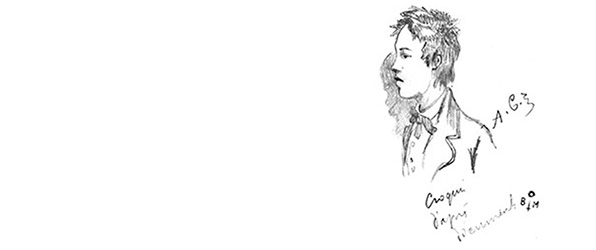
The poet Paul Verlaine, Rimbaud's male lover, said of his decision to abandon writing poetry at just twenty-years old: "one big reason [and] perhaps obvious, is he grew up ... the child in him died".
Arthur Rimbaud and Important Artists and Artworks
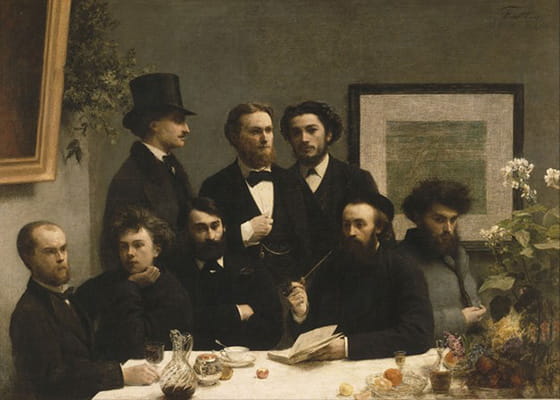
By the Table (1872)
This painting features several influential French writers, and members of the Parnassus poetry group. Fantin-Latour was well known for his group portraits, which he typically arranged in rows of figures in the manner of 17th-century Dutch guild portraiture. Although academic in style (he was also well known for his still lifes), Fantin-Latour was well connected with the French modernists and portrayed intellectuals and artists as avant-garde heroes. The academic style of this portraits, executed, as it was, with fine brushwork, and which present the sitters with thoughtful expressions, serves to legitimize their status as men to be reckoned with. However, despite its sober and benign presentation, the painting alludes, in fact, to the ambivalence that existed within the group's members.
Seated, from left to right are: poet (and Rimbaud's lover) Paul Verlaine, Rimbaud, poet Léon Valade, poet and journalist Ernest d'Hervilly, and politician and journalist Camille Pelletan. Standing, from left to right are: poet and dramatist Pierre Elzéar, playwright, poet, art critic, and journalist Emile Blémont, and poet Jean Aicard. All the men wear black, except for Pelletan (the only member of the group who was not a poet). The vase of flowers on the right side of the frame is symbolic. The flowers are a substitute for the poet Albert Mérat who was invited to sit for the portrait but declined on grounds that he "would not be painted with pimps and thieves" (a thinly veiled reference to Verlaine and Rimbaud). Indeed, Mérat was most active in the defamation of Rimbaud and Verlaine, leading to their being held in contempt by others in their literary circle, not least by the poet Stéphane Mallarmé, who, while acknowledging his "meteor-like" impact on the literary avant-garde, later dismissed Rimbaud a "bourgeois trafficker".
In her reading of the painting, art historian Bridget Alsdorf asserts that the "strain and disconnect" between group members, which can be detected here in the way Rimbaud turns his back on the other people in the portrait, should not be considered as "a failure to achieve pictorial 'coherence'", but rather evidence of the "fragile nature of their collective life".
Oil on canvas - Musée d'Orsay, Paris, France
Portrait of Arthur Rimbaud (1933)
French artist and writer Valentine Hugo first had the idea to paint Rimbaud after dreaming about him. When she told Surrealist leader André Breton about her dream, he encouraged her to paint her vision. Portrait of Arthur Rimbaud was executed in a style similar to her portraits of other Surrealists (including Breton, Paul Éluard, René Crevel, and Tristan Tzara), with the subject's head emerging from the dark in a ghostly apparition. In general, Hugo's painting deals with several dualities, including male and female, love and pain, biography and autobiography.
Rimbaud's head is seen floating above what appears to be a pool of red and green water populated by sea urchins and other strange aquatic creatures (perhaps alluding to a scene described by Rimbaud in his 1871 poem Le Bateau Ivre (The Drunken Boat)), below a black sky dotted with rhinestone stars. Two intertwined birds, one eagle, and one that looks like a swan with reddish-brown feathers, float above Rimbaud's head. The poet's irises are almost completely white, causing his gaze to effectively "pierce" the viewer. The swan-like bird appears to be protecting Rimbaud from the eagle's sharp beak and it holds a laurel wreath (a traditional symbolic signifier of poets) in front of his forehead. Several black crows can also be found amidst the feathers of the swan-like bird, referencing Rimbaud's poem Les Corbeaux (The Crows) (1871). Author Enid Rhodes Peschel argues that, in the poem, the crows represent "contradictory qualities: ugliness and beauty, repulsion and attraction, evil and good, physical death and spiritual essence". Other objects in the paintings, such as extracts from one of Rimbaud's letters, and the seal of Menelik II, the future king of Ethiopia, reference his activities during the later years of his life.
It is likely that Hugo felt a particular connection to Rimbaud, not just because he championed the exploration of the subconscious, but also because of other parallels between their lives. Both Rimbaud and Hugo had affairs with other poets (Hugo was involved with Breton from 1931-32) that ended in misery (in fact, Hugo was so distraught over the end of her relationship with Breton that she attempted suicide). Historian and curator Hannah Noel-Smith, notes that other elements in the paintings may relate more to Hugo's life than to Rimbaud's, such as a sea erchin (sand dollar) at the lower left, which is similar to one known to be have been owned by Breton. Moreover, as Noel-Smith explains, French poet Jean Cocteau "called Hugo his 'little swan', and perhaps in this work she represents herself in swan form, looming over Rimbaud/Breton; be it as revenge, an act of love, or to finally place herself within the [Surrealist] movement".
Oil on panel with inlays of glass, and collage - Private collection
Hommage a Rimbaud (Homage to Rimbaud) (1960)
This work is by Spanish artist Joan Miró, who was loosely affiliated with the Surrealists. Hommage a Rimbaud was created for the book Arthur Rimbaud Vu par les Peintres Contemporains (Arthur Rimbaud Seen by Contemporary Painters) (1962), a series of prints intended as a collective homage to Rimbaud, by nine different artists: Miró, Jean Arp, Georges Braque, Jean Cocteau, Max Ernst, Valentine Hugo, Alberto Giacometti, Pablo Picasso, and Jacques Villon. The image includes splotches of vivid red, blue, yellow, orange, pink, and purple, with thin black lines meandering across the surface. The vivid colors can be understood as representing different periods in Rimbaud's life, as he experienced joy and love, pain and suffering, with the vibrant hues communicating a generally positive view of Rimbaud's life. The black lines may represent the centrality of wandering and adventure to Rimbaud's life, both in regard to the way he travelled internationally, and the way he engaged in a wide range of personal, professional, and poetic endeavors. The brevity of his life itself is possibly encapsulated in the fact that the image occupies only a small portion of the full page.
According to art historian Alexandra (Mac) Taylor, Miró "was a man more at home with poets than painters", and he was particularly enamored with Rimbaud's "irrational" poem "Après le Déluge" ("After the Flood"), which includes the lines "just as the idea of the Flood went subsiding/ A hare stopped in the swaying clover and flower bells/ and said its prayer to the rainbow, through the spider's web". Taylor explains that "Believing the painter should work as the poet would, [Miró] approached his canvases with the intention of provoking accidents, accidents which would manifest themselves in a form or a splotch of color". Taylor observes that Miró was heavily influenced by Rimbaud in the creation of two other works, Untitled (1934) and Figure (1934), both of which contain "devilish imagery" and "hellish tones - shades of color which bring to mind ideas of burning, of rot, of a morbid atmosphere" that allude to Rimbaud's poem "Night in Hell" (1873).
Color lithograph - Philadelphia Museum of Art
Homage à Rimbaud (Hommage to Rimbaud) (1961)
Ernst, like Rimbaud, aspired to transcend the status of mere "artist" by becoming "voyant" ("visionary" or "seer"). This etching, dedicated to the poet's memory, also belongs to the collection of works (with eight other artists), Arthur Rimbaud Vu par les Peintres Contemporains (1962). Ernst's contribution, that features a curved, shell-like shape overlaid with wavy parallel lines and random splotches, is highly abstracted, and somewhat cryptic. The work thus defies any definitive interpretation. But one can gain some grasp of its meaning by understanding the influence that Rimbaud had had on Ernst's worldview, and especially his "unglued collages" which challenged the fixed cut and paste technique being used by Ernst's contemporaries.
Around the mid-1930s, Ernst formulated a theory of collage for which he adapted much of Rimbaud's approach to poetry. Comparative Literature scholar, Felice C. Ronca, Ronca, writes that Ernst's "unglued collages" through their "witty transformations of popular images and clichés executed with clarity and precision, represented a radical departure from the traditional scissors and paste technique of the earlier Cubist papers collés, which was still being practiced by Ernst's contemporaries [Jean] Arp and [Kurt] Schwitters". Even the Surrealist ideal of écriture automatique (automatic writing), which had been a practice pioneered by Rimbaud, proved in the end to be "too much affected by stylistic and formal considerations, and too involved with the representation of 'real' objects to be entirely suitable for Ernst's purposes".
Ronca concludes, "For both Ernst and Rimbaud, the raw material that fuels the creative imagination is the printed word or the printed reproduction of a visual image". In Rimbaud's writing "we experience the brutal and traumatic struggle of the artist to break free of social conventions and popular prejudices, to exercise self-determination, and to find a new way of approaching reality in its true nature without violating the self". For Ernst, this idea transferred directly to the "mechanism of collage" which, as he saw it, consisted "of these two complementary processes with the satisfactions of re-integration validating the arduous struggle to become voyant".
Etching and aquatint in blue-gray and pale pink - National Gallery of Art, Washington D.C.
The Deer Park (1962)
By 1962, the School of London figurative artist, Michael Andrews, was becoming increasingly interested in collage and started to produce collage-like composition featuring figures from different periods in history. Andrews had gained a reputation for being a painstakingly slow painter. The Deer Park represented a self-conscious move on the artist's part to work in much more spontaneous way. As historian Mark Hallett writes, "The picture is a hectic and confusing one, and deliberately so. It is structured by the roller-coaster sweep and plunge of a balcony and stairwell down to its left, and by the odd combination of semi-transparent screen and curved viewing platform on its right. This strange, almost free-floating, architecture pours forth a crowd of men and women who variously dance, embrace, sit, and talk, and who spill out into the lush green landscape in the background. The painting's sense of flux and uncertainty is reinforced by its sketch-like and visibly rushed character; it really does have the feel of a picture painted in a hurry".
The Deer Park is inspired by Norman Mailer's 1955 novel of the same name. It tells a story of Sergius O'Shaugnessy who, after "winning big" at a poker game, travels to the fictional Desert D'Or, where he meets several Hollywood celebrity types, as well as a misanthrope named Marion Faye who Andrews represents here as Rimbaud. The image of Rimbaud is copied by Andrews directly from Henri Fantin-Latour's, group portrait, By the Table, (1872), and he is being stared at directly by the "slouching" Allen Ginsberg (an image based on an earlier picture of the Beat poet taken in Paris in 1956).
Hallett writes, "Andrews, like many other painters and writers of the beat era, seems to have valorised [Rimbaud] as the quintessential bohemian and outsider [...] Nevertheless, Andrews seems to have identified with Rimbaud to a rather extraordinary degree. [He] remembered reading 'a lot' of Rimbaud during the time he was painting Deer Park, explained his choice of pictorial model by noting that 'Marion Faye must have had a deadly kind of charm and was guided by fate and Rimbaud was a parallel figure". Historian Ben Tufnell (cited by Hallett) adds that "the introduction of the poet's portrait into Deer Park also proclaims Andrews's own adherence to the ideal of artistic freedom for which Rimbaud served as such a talisman. More particularly, Rimbaud's presence at the centre of the painting seems to symbolise and express the forms of artistic freedom, even of liberation, that Andrews himself experienced when painting this work, which he later wrote was 'one of the pictures which has given me the greatest excitement painting'".
Oil on board - The Tate, London
Arthur Rimbaud in New York (Times Square) (1978-79)
For his photographic series Arthur Rimbaud in New York, David Wojnarowicz created a mask of Rimbaud (from a photograph taken by Etienne Carjat of the poet when he was age seventeen) out of cardstock and a rubber band. Wojnarowicz wore the mask and photographed himself in several situations, such as riding the subway, masturbating in bed, attempting to cross a busy street, and posing with a needle in his left arm with a bandanna as a tourniquet. These situations were some of the things Wojnarowicz imagined Rimbaud would have done were he to live longer and had he found his way to New York. Yet the series is also semi-autobiographical, capturing scenes in locations of significance to Wojnarowicz, particularly places around Times Square where he had spent his years as a homeless teenaged prostitute.
Journalist Moira Donegan maintains that "Wojnarowicz identified with Rimbaud when he took those photos, and in the twenty-six years since his death, he has become a Rimbaud-like figure: young, iconoclastic, gay, and gone too soon" (Wojnarowicz also died aged 37). Art historian and critic Lucy Lippard considers the images in the series to be "a kind of objective autobiography", which are "beautifully composed and shot". Besides the overlaps between Rimbaud and Wojnarowicz, such as their struggles with neurotic mothers, their homosexual relationships, their substance abuse, and daily struggles with restlessness, poverty and homelessness, the series also suggests a connection between Paris of the 1870s, and New York of the 1970s. Both cities, at these times, were bohemian hubs in which artists, poets, and other creative intellectuals congregated. Yet Paris and New York were also cities with a disturbingly dark side, and countless young optimists found themselves "chewed up and spat out" by the city experience. Indeed, curator Salvador Nadales views Wojnarowicz's series as "a contemplation of the end of the experimental artists' collectives on the Lower East Side, as gentrification and urban speculation transformed the neighbourhood, and AIDS had begun to decimate the gay community".
Gelatin silver print on paper - The New York Public Library
Biography of Arthur Rimbaud
Childhood and Education
Jean Nicolas Arthur Rimbaud was the second son of Frédéric Rimbaud, a cultured infantry captain, and Marie Catherine Vitalie Rimbaud, the daughter of a successful farmer. The couple would have a further three children (all girls) although one passed away at only a few weeks old. Rimbaud's father was rarely at the family home in Charleville, in the northeast of the country due to various military postings. In 1860, he left the household for good, though his parents never officially divorced. As the author and essayist Daniel Mendelsohn writes, "When Arthur was five, his father went off to join his regiment and never came back. The memory of the abandonment haunts Rimbaud's work, which often evokes lost childhood happiness, and occasionally seems to refer directly to his family's crisis. ('She, / all black and cold, hurries after the man's departure!') Vitalie, devoutly Catholic, took to calling herself 'Widow Rimbaud,' and applied herself with grim determination to her children's education".
While Rimbaud's father was an easy-going, congenial man, his mother had a more complex personality. She focused most of her energies, and pinned all of her ambitions, on young Arthur. She was stubborn, bigoted, authoritarian, and narrow-minded, and Arthur secretly referred to her as the "Mouth of Darkness". In 1862, fearing that the poor children of the neighborhood were a bad influence on her own children, she moved the family to the higher-income area of Cours d'Orleans.
The Rimbaud brothers had been homeschooled by their mother. But after the move, she enrolled them at the Pension Rossat school which they attended for the next five years. However, the boys were controlled by their mother, who insisted on walking them to school, and generally meddled in their learning. She would frequently dispense punishments, such as rote-learning 100 lines of Latin verse (at the age of nine, Rimbaud wrote a 700-word essay on why he hated learning Latin) or even making them go without meals.
The young Rimbaud did inherit his mother's deep Catholic faith and took his First Communion aged eleven. In these early years, he mostly read the Bible, though he also enjoyed fairytales and adventure stories by authors such as James Fenimore Cooper and Gustave Aimard. When Rimbaud was twelve, his mother sent him and his brother to the Collège de Charleville, where he excelled in his studies, winning fourteen first prizes in the French academic competitions in his first two years, including a prize for Religious Education. He was starting to show early signs of rebelliousness, however, by scrawling "Shit on God" on the walls of local buildings.
Father Ariste Lhéritier, employed by Rimbaud's mother as a private tutor, was the first to encourage the boy to try his hand at writing his own verses in French and Latin. When he was still just fifteen, his poem "The Orphans' New Year Gifts" was published in the cultural periodical, La Revue Pour Tous. He won the first prize for a Latin poem at the Concours Académique in the same year. French professor Margaret C. Davies-Mitchell writes that, as a teen, "Rimbaud seemed obsessed with poetry, spending hours juggling with rhyme. This firm grounding in the craft of versification gave him a complete, even arrogant confidence and an ambition to be acknowledged by the currently fashionable Parnassian poets, of whom he was soon producing virtuoso pastiches".
At this time Rimbaud also fell under the influence of a young rhetoric teacher, Georges Izambard. The two developed a close relationship, which Izambard assuming a paternal role in the boy's life. Rimbaud's mother did not approve of Izambard's influence on her son, however, and wrote him a letter objecting to his having given her son a copy of Victor Hugo's 1862 novel Les Misérables on the grounds that it posed a danger to his moral character. By his mid-teens, it seems that Rimbaud had rejected all conventional religious belief, as well as other values his mother had tried to impress upon him, such as hard work, patriotism, and class-based snobbery.
Prolific Period
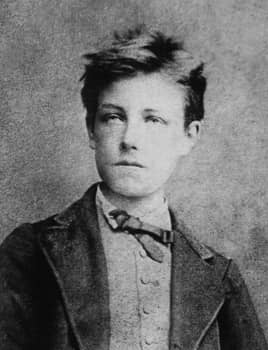
When the Franco-Prussian War broke out on July 19, 1870, the Collège de Charleville was turned into a military hospital, and Rimbaud's beloved teacher Izambard left town to stay with his aunts in Douai. It marked the end of Rimbaud's formal education. Growing bored, he decided to run away by train to Paris. As he had no money and had not purchased a ticket, he was arrested for fare evasion and vagrancy upon arrival and put into Mazas Prison to await trial. On September 5, he wrote a letter to Izambard, begging him to come to his rescue. Izambard arranged with the prison governor to have Rimbaud released into his custody. He subsequently returned the boy to his irate mother.
It wasn't long before Rimbaud ran away again (twice). The previously dutiful boy was now boorish and disrespectful, growing his hair long, becoming involved in petty theft (stealing books from local shops), and drinking heavily. The drinking would certainly have upset his mother, who had two alcoholic brothers. His poetry and letters to his friends (including Izambard) also indicated a change. They were sporadic and their content hinting at mental instability. In a letter to Izambard, Rimbaud wrote: "I'm now making myself as scummy as I can. Why? I want to be a poet, and I'm working at turning myself into a seer. You won't understand any of this, and I'm almost incapable of explaining it to you. The idea is to reach the unknown by the derangement of all the senses. It involves enormous suffering, but one must be strong and be a born poet. It's really not my fault".
Rimbaud's first significant poem, written when he was still just sixteen years of age, was The Drunken Boat, an allegorical account of his own youth. The poem uses the metaphor of a boat on a tumultuous river, which occasionally encounters calm moments, to represent his own state of mind. In it, he wrote, "I drifted on a river I could not control/ No longer guided by the bargemen's ropes [...] When my bargemen could no longer haul me/ I forgot about everything and drifted on". Artist and filmmaker Kathleen Barth notes that Rimbaud's suggestive manner of connecting himself to the metaphor of the boat "parallels the symbolists' reliance on suggestion rather than statement," while his "use of form provides the ultimate defiance against the Parnassians [poems composed of verses]. Rimbaud mocks what he saw as the elementary simplicity of Parnassian poetic structure by incorporating regular rhyme and rhythm in his own poem".
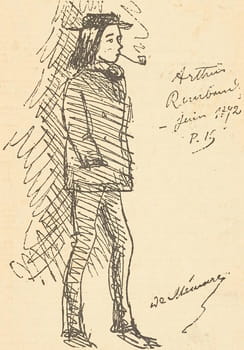
When Rimbaud turned 16, he wrote to the Symbolist poet Paul Verlaine. He greatly admired Verlaine's work and attached his own poems to the letter. To Rimbaud's astonishment, Verlaine liked his writing and invited him to Paris in 1871 (even paying his travel expenses). Rimbaud was welcomed as a house guest of Verlaine and his new wife, but quickly outstayed his welcome due to his bad manners and a general lack of sociability. However, he and Verlaine began a sexual relationship, and Verlaine left his wife (shortly after the birth of their son) to be with Rimbaud. Mendelsohn writes, "The rules of poetry weren't the only things that Rimbaud broke when he arrived in Paris. Among other things - bric-a-brac, dishes, and furniture in the various homes where he was offered hospitality, and where his boorish behavior inevitably led to his eviction - he broke up Verlaine's marriage. The two men apparently became lovers soon after Rimbaud's arrival, embarking on an affair that scandalized Paris and made literary history". He notes that Verlaine's brother-in-law was one of the few not "taken in by the angelic face and striking pale-blue eyes" and denounced Rimbaud as a "'vile, vicious, disgusting, smutty little schoolboy whom everyone [else] is in raptures about.'".
Over the next two years, the two men lived in Paris, where they rubbed shoulders with the literary stars of the day, and overindulged in alcohol, opium, and hashish. They also spent some time in Belgium and England. Their relationship quickly became strained, due in no small part due to their substance abuse and poverty. Speaking of their love affair, Mendelsohn writes, "Many readers and biographers see the couple as what one critic calls 'the Adam and Eve of modern homosexuality,' but the evidence suggests that, as far as Rimbaud was interested in anyone other than himself, he was interested primarily in women [...] It is hard to escape the feeling that Verlaine, an ugly man whose appearance Rimbaud made cruel jokes about, was a kind of science experiment for the poet, part of his program of 'rational derangement of all the senses,' his strident adolescent ambition to 'reinvent' love, society, poetry". The love affair came to an abrupt halt in London in September 1872 when Verlaine suddenly decided to abandon Rimbaud and return to France to his wife and child.
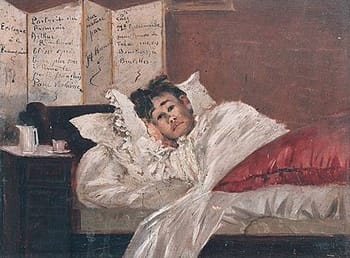
In September 1873, Verlaine, who was starting to miss Rimbaud, telegraphed him and asked him to meet at the Grand Hôtel Liégeois in Brussels. The reunion was not a success. A drunken Verlaine shot Rimbaud in the hand and was subsequently sentenced to two years in prison. Rimbaud returned to Charleville and wrote his prose masterpiece A Season in Hell.
Though the book was published in Belgium that year (and in fact was the only work that Rimbaud published himself), most of the copies languished in the printer's basement until 1901, as Rimbaud was unable to settle his bill. Barth explains that "For A Season in Hell, Rimbaud eschews formal verse altogether and writes the entire poem in free verse. He also abandons metaphor-based organization and his suggestive manner of writing for a more direct narrative". Mendelsohn put it this way: "If you were to take Dante's 'Inferno,' Dostoyevsky's 'Notes from Underground,' a pinch of William Blake, and a healthy dash of Christopher Smart's madhouse masterpiece 'Rejoice in the Lamb,' throw them into a blender and hit 'purée, you might well find yourself with something like 'A Season in Hell.'".
In 1874, Rimbaud spent two months living in London with poet Germain Nouveau. It was during this period that he wrote his famous collection of forty-two prose poems. Inspired by the French poet Charles Baudelaire, the collection was titled Illuminations. French literature professor Margaret C. Davies-Mitchell writes that with Illuminations, "Rimbaud reached the height of his originality and found the form best suited to his elliptical and esoteric style. He stripped the prose poem of its anecdotal, narrative, and descriptive content and used words for their evocative and associative power, divesting them of their logical or dictionary meaning. The hypnotic rhythms, the dense musical patterns, and the visual pyrotechnics of the poems work in counterpoint with Rimbaud's playful mastery of juggled syntax, ambiguity, etymological and literary references, and bilingual puns". Critic Charles Bainbridge calls Illuminations "one of the most exciting and haunting pieces of literature ever written," and understands it as the culmination of Rimbaud's desire to achieve "a long, prodigious and reasoned disordering of all the senses".
Rimbaud's works between 1870-75 deal with a range of subjects, such as the absurdity of war, the horrors of poverty, the hypocrisy of the bourgeoisie, and the joys of living a free, bohemian lifestyle. Many pieces are also vehemently anti-Christian, and clearly intended to cause shock and outrage, making frequent use of "ugly" words. Technically, his poetry sought to challenge the conventions of traditional verse, and to take both writer and reader on unexpected, sensual adventures into new realms or writing.
By 1875, however, and just five short years after it had begun, a twenty-year-old Rimbaud had abandoned his career as a writer (the only evidence of his writing after this date are his letters, in which he complained constantly to family and friends about his ongoing financial struggles). Mendelsohn writes, "The apparently irreconcilable extremes of his thought and behavior are easier to account for when you remember that Rimbaud the poet never reached adulthood: violent oscillations between yearning and contempt, sentimentality, and viciousness, are not unheard of in adolescents. (The Surrealist André Breton described Rimbaud as 'a veritable god of puberty.') Like J. D. Salinger, another beloved celebrant of youthful turmoil, Rimbaud may simply have found that, as he grew up, the urgency of his subject was gone. There was nothing left to say".
Late Period and Death
After quitting poetry, Rimbaud studied Italian, Spanish, and German, and committed to touring Europe, often on foot, seeking adventure and opportunities to make money. In May 1876, he enlisted as a soldier in the Dutch Colonial Army, though his intention was only to gain free passage to Java in the Dutch East Indies (now Indonesia). After a few months, he fled into the jungle, deserting the army, thereby risking execution were he to be caught. Fortunately for him, he escaped detection, before eventually returning to France by ship.
In 1877, Rimbaud spent some time working in a traveling circus in Sweden and Denmark before, in December 1878, arriving in Cyprus where he took a job as a stone quarry foreman. After five months in Cyprus, he contracted typhoid and returned to France. Critic John Tranter writes that, in March 1880, Rimbaud "found work in Cyprus again, as a foreman of a construction gang in the mountains. He got involved in a quarrel and, it seems, threw a stone which hit a local worker on the temple and killed him. Rimbaud fled, travelling through the Red Sea - further and further from Europe - and ending up in the British port of Aden, a sun-baked volcanic crater perched at the gateway to the Indian Ocean and the coast of Yemen".
![Rimbaud pictured in Harar, Ethiopia, in 1883. Mendelsohn writes that, while in Ethiopia, Rimbaud entered into a relationship “ with a strikingly good-looking local woman [who] wore Western clothes and smoked cigarettes”.](/images20/photo/photo_rimbaud_arthur_4.jpg)
Once in Aden, Rimbaud worked for Alfred Bardey, a coffee trader. Already fluent in English and German (and with a working knowledge of Latin, Greek, Spanish and Italian) he quickly took to native languages and dialects. Tranter writes that "once he'd learned the ropes and proved himself useful and trustworthy, Bardey asked him to set up a branch of the business in Harar, five hundred kilometres from Aden [...] in the highlands of Abyssinia, as Ethiopia was then". The route to Harar was perilous as it was policed by the notorious Danakil tribesmen (they had recently attacked a French trader and his wife, killing them and their twenty Abyssinian guards, taking their testicles as battle trophies). Rimbaud risked the journey and once in Harar, befriended the Governor, Ras Makonnen Wolde Mikael Wolde Melekot, father of future emperor Haile Selassie.
In Harar, Rimbaud was soon trading on his own behalf. As Tranter explains, "he had developed a circle of friends among the Africans as well as the Europeans. He had a devoted servant, a beautiful Abyssinian mistress, and a busy schedule. He'd earned the esteem of the society he'd chosen to join". However, Rimbaud was not happy with his new life (which, Tranter suggests, had been rather forced on him following the killing of his fellow workman in Cyprus). Tranter makes his point by citing Rimbaud's letters home (mostly to his mother) in which he wrote (between 1882-84): "I am like a prisoner here" [...] "I am by now completely habituated to every form of boredom" [...] "My life here is like a real nightmare. Don't imagine I am enjoying it at all [...] I feel that I am becoming very old very quickly, in this idiotic occupation, in the company of savages or imbeciles".
In February 1891, Rimbaud was back in Aden, and began to develop pain in his right knee, which was misdiagnosed as arthritis. However, within a month, he had failed to respond to treatment and the leg became so painful that he returned to France via an agonizing thirteen-day voyage. He was admitted to the Hôpital de la Conception in Marseille where, one week later, his leg was amputated. It was only after the amputation that doctors made the correct diagnosis: bone cancer.
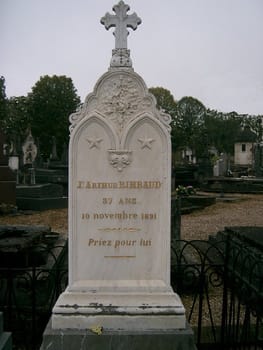
After being discharged from hospital, Rimbaud spent a month recuperating at his family's farm in Roche. Ever restless, he attempted to return to Africa, but continuing poor health on the journey forced him to return to the hospital in Marseille, where his sister Isabelle attended his bedside. He received his last rites and passed on November 10th, 1891, shortly after his thirty-seventh birthday. He was buried in Charleville-Mézières, next to his sister Vitalie. In 1895, Verlaine oversaw the publication of Rimbaud's complete works.
The Legacy of Arthur Rimbaud
The French poet Stéphane Mallarmé described Rimbaud as a "meteor, lit by no other reason than his presence, arising alone then vanishing". It is certainly true that Rimbaud's literary career shone bright and fast, but he had done to leave his imprint on the ascent of modernism. In his own lifetime, Rimbaud was seen as a key contributor to the Symbolist cause. And, through what is perhaps the most influential of all Rimbaud's texts, Une Saison en Enfer (A Season in Hell) (1873), he influenced many Dadaists and Surrealists. But Rimbaud's influence stretched much further into the twentieth century.
French and comparative literature professor Carrie Noland traces Rimbaud's legacy, through its influence on the Situationists of the 1960s, to its influence on 1970s punk subculture. As she says "it was the linguistic strategies we associate with the lyric genre - and not simply the myth of the French voyou (hooligan, punk) - that inspired the work of both punk musicians and their avant-garde predecessors. Mendelsohn adds that the famous American novelist, Henry Miller, compared his poem "The Time of the Assassins", to "the release of the atomic bomb", while "English language poets including Samuel Beckett and John Ashbery have translated and been influenced by Rimbaud's works". Even a sixteen-year-old Patti Smith, enduring the drudgery of working in a New Jersey factory, stated that her "salvation and respite from my dismal surroundings was a battered copy of Arthur Rimbaud's Illuminations, which I kept in my back pocket [it] became the bible of my life".
Influences and Connections

-
![Charles Baudelaire]() Charles Baudelaire
Charles Baudelaire ![Victor Hugo]() Victor Hugo
Victor Hugo- James Fenimore Cooper
- Gustave Aimard
- Georges Izambard
- Paul-Marie Verlaine
- Germain Nouveau
-
![André Breton]() André Breton
André Breton ![Samuel Beckett]() Samuel Beckett
Samuel Beckett![John Ashbery]() John Ashbery
John Ashbery![Allen Ginsberg]() Allen Ginsberg
Allen Ginsberg- André Freynaud
- Georges Izambard
- Paul-Marie Verlaine
- Germain Nouveau
-
![Dada]() Dada
Dada -
![Surrealism]() Surrealism
Surrealism -
![Punk and Post-Punk Art]() Punk and Post-Punk Art
Punk and Post-Punk Art ![Situationism]() Situationism
Situationism
Useful Resources on Arthur Rimbaud
- Arthur Rimbaud (Critical Lives)Our PickBy Seth Whidden
- Somebody Else: Arthur Rimbaud in Africa, 1880-91By Charles Nicholl
- Arthur Rimbaud: A BiographyOur PickBy Enid Starkie
- Disaster Was My God: A Novel of the Outlaw Life of Arthur RimbaudBy Bruce Duffy
- Rimbaud: The Double Life of a RebelBy Edmund White
- Rimbaud: A BiographyOur PickBy Graham Robb
- Arthur Rimbaud: Complete WorksOur Pick
- Illuminations
- I Promise to Be Good: The Letters of Arthur Rimbaud (Modern Library Classics)Our Pick
- Collected Poems (Oxford World's Classics)Our Pick
